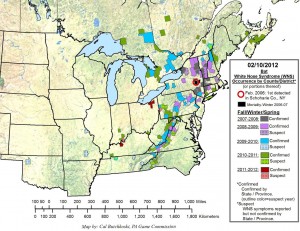In the article “New Roads in the Amazon May Deliver Disease” by Joanne Silberner posted on the disease section, biostatistician Bill Pan discusses how pools of water form alongside roads and act as nesting grounds for mosquitoes that are potentially infected with malaria. I found this piece of information interesting as when generally thinking about how disease spreads, I had only considered the migration of people from one location to another as the sole cause. In addition, it is known that there are many cons associated with building a road, but I feel that this is an issue that is often overlooked.
Category Archives: Disease
NYC’s Metro Mitt a creative idea, but does it actually do anything?
 Designed to reduce the risk of catching a disease on the subway, these metro mitts are available for free at many of New York City’s subway locations. Not only do the mitts look incredibly tacky, but will this thin sheet of plastic really help prevent people from all of the germs in the subway? Although the Metro Mitt will help reduce the risk of germs on your hands, there still remains thousands of other ways to contract a disease on a subway.
Designed to reduce the risk of catching a disease on the subway, these metro mitts are available for free at many of New York City’s subway locations. Not only do the mitts look incredibly tacky, but will this thin sheet of plastic really help prevent people from all of the germs in the subway? Although the Metro Mitt will help reduce the risk of germs on your hands, there still remains thousands of other ways to contract a disease on a subway.
photo retrieved from http://gawker.com/5788169/the-disposable-subway-riding-glove-is-completely-idiotic
HIV Spread along Mombasa Road, Kenya
HIVAIDS part 3 – Mombasa Road, Kenya (The spread of HIV) – YouTube
This video created by the Salvation Army highlights the spread of HIV in Africa along roads. Truck drivers are interviewed in regard to their role as a transportation vector for the disease. Interviewees recognized the dangers presented by the disease but showed little to indicate a change in behavior. HIV will continue to spread along roads as long as people’s behaviors and awareness do not change because roads allow for more people to come in contact with the disease and allows HIV to spread over vast distances rapidly.
Podcast: Play in new window | Download
The virus crisis
This National Geographic video highlights how deadly rainforest viruses have transported from their animal hosts, and across continents. West Nile Virus is an example of how the world’s increased globalization has made people more vulnerable to deadly diseases. The virus is native to a very specific ecology of birds and streams in Africa. “No one could have imagined it [West Nile] could have emerged in the concrete jungle of Manhattan and Queens,” said Laurie Garrett, a science writer featured in the video.
The Economically Devastating Foot-And-Mouth Disease (FMD)
The Britannica Encyclopedia writes a good entry about Foot-And-Mouth Disease (http://www.britannica.com/EBchecked/topic/212824/foot-and-mouth-disease-FMD), the most economically devastating livestock disease in the world. Because the virus is so easily transmitted, ranchers and even governments must go at great length to contain outbreaks. They do this by disinfecting automobiles, cleaning roads, and monitoring traffic. Although this disease is not common in the United States, it is what ranchers in Latin America and the world fear the most.
Environmental Change and Infectious Disease – Rural Ecuador
A professor from the University of Michigan’s school of Public Health made an interesting connection between expanding road networks and diarrheal pathogens in the remote rainforests of northern Ecuador. His study indicated that higher rates of infection (up to 8 times higher in some cases) were found at closer distances to the main roads, and showed that villages better connected by the new road networks also experienced higher rates of infection. An InFocus article on the University of Michigan’s website focused on his study and noted that the study of epidemiology and the spread of disease needs to account for broad socio-economic, ecological, and economic patterns.
Airports act as ideal hubs for disease transmission
The Homeland Security News Wire published an article in March 2011, “Stemming the spread of diseases at airports”, which focused on airports acting as ideal places for dangerous diseases to quickly and easily transport themselves to other countries in a matter of hours. The CDC is quoted saying “Advancements in transportation coupled with the growth and movement of human populations enable efficient transport of infectious diseases almost anywhere in the world within 24 hours.” This quote emphasizes the importance of amping up security in airports. Thermal scanners could be used in order to detect fevers, a sign of infectious disease, in passengers moving throughout the airport. These scanners could help prevent the spread of diseases, such as SARS and measles, which are two of many ailments that are spread rapidly by air travel. With 2 million people traveling through airports every day, it is a serious challenge to contain major disease outbreaks.
The Spread of White Nose Fungus in Bats
Over the past several years a new type of disease has been decimating bat colonies in the northeastern part of the United States. Researchers have found entire colonies of brown bats dead in their caves with the telltale white fungus on their noses that is characteristic of of this disease. This disease, which has become known as White nose syndrome is estimated to have wiped out up to 90% of Connecticut’s brown bat population. What is more concerning is that it is spreading. This map illustrates the spread of White nose syndrome over the past few years. It i interesting to note that the disease seems to be spreading along the physical barrier of the Appellation mountains. To learn more about White nose syndrome visit the US Fish and wildlife service website.
Road access introduce Chimpanzees to foreign disease
Road intrusions into natural habitat space facilitate increased human activity in the area, due to the increased ease of access. When humans arrive, they bring their sicknesses and germs with them. This video explains how efforts to increase human tourist traffic are introducing the chimpanzees of the Mahale Mountains National Park in Tanzania to fatal illnesses, and can serve as a valuable case study in road’s impacts on the health of wildlife.
Deforestation is only the beginning
While roads may bring short-term (and in some cases long-term as well) economic boosts, the end result may negatively affect human health. Unfortunately, numerous newly-constructed roads in the Amazon illustrate this, as can be shown in studies performed by John Hopkins researchers. This article examines the relationship between roads, deforestation, and malaria.



